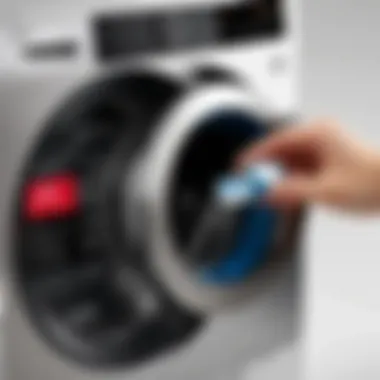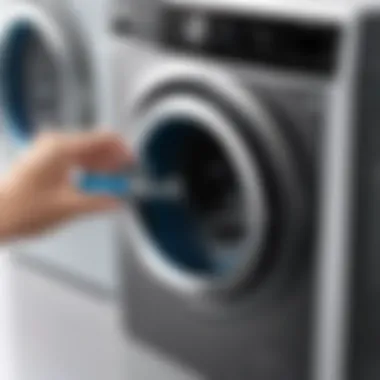Understanding the LG Washing Machine Valve: A Comprehensive Guide


Intro
The LG washing machine valve plays a crucial role in determining the overall functionality of your appliance. Its primary purpose is to manage water flow into the machine, ensuring that each cycle operates effectively. Not understanding this component can lead to operational issues, which may negatively impact washing performance. This guide aims to help users comprehend the various technical aspects, common problems, maintenance tips, and replacement options regarding the LG washing machine valve. By grasping these details, consumers can make informed decisions that will benefit their appliance longevity.
Technical Specifications
Detailed Product Specs
The LG washing machine valve is engineered with specific specifications that make it essential for appliance operation. The common types include inlet and outlet valves. The inlet valve typically consists of various features, such as:
- Material: Usually made from durable plastic or brass.
- Electrical Connection: Designed for compatibility with standard LG washing machines.
- Flow Rate: Measured in liters per minute, which often ranges between 10 to 20 liters, depending on model.
Performance Metrics
Performance metrics for the LG washing machine valve can significantly affect washing efficiency. Some important metrics include:
- Opening and Closing Speed: Determines how quickly the valve responds to control signals.
- Leak Test Results: Ensures the valve does not leak under operational pressure.
- Temperature Ratings: Typically rated for operation up to 60 degrees Celsius.
Compatibility Information
Compatibility with various LG washing machine models is key. Most LG valves are designed to fit several models, making them versatile. However, users should verify compatibility before purchasing to avoid installation issues. Checking the model number and valve specifications can ensure proper fitment.
Common Issues
In this section, we can highlight the issues often faced with the LG washing machine valve.
Common Problems
- Leakage: A frequent problem where water drips from the valve.
- Clogging: Dirt buildup can obstruct proper flow.
- Electrical Failures: These can affect the valve's opening and closing mechanisms.
Maintenance Requirements
Regular maintenance is crucial for optimal performance. This may involve:
- Periodic Inspection: To check for visible wear or leaks.
- Cleaning: Removing debris or mineral deposits.
- Testing Electrical Connections: Ensuring they function correctly.
Replacement Guidelines
If issues persist, replacing the valve might be necessary. Follow these steps:
- Disconnect Power: Safety is paramount.
- Turn off Water Supply: Prevent leaks during replacement.
- Remove Old Valve: Carefully detach it from the washing machine.
- Install New Valve: Follow manufacturer instructions for installation.
Latest Trends
Industry Developments
The washing machine industry is evolving, and LG is at the forefront, introducing innovative features for valves. Smart technology enhances control and monitoring capabilities. This trend is indicative of broader movements toward automation in home appliances.
Emerging Technologies
Recent advancements involve valves that feature:
- Sensors: To detect malfunctioning conditions.
- Smart Controls: Allowing integration with home automation systems.
Future Predictions
In the future, we may see more energy-efficient designs and improved materials that prolong lifespan and enhance reliability.
Buying Guides
Recommended Products
Brands such as LG offer several valve options. Always select one compatible with your machine model. Reading reviews and ratings may aid in decision-making.
Purchasing Tips
- Check Specifications: Match them with your machine.
- Warranty Information: A longer warranty often signifies quality.
- Compare Prices: Ensure you are getting the best deal.
Warranty and Support Information


LG generally offers robust customer support. Users should take advantage of warranty services for replacement or repairs when issues arise.
By understanding the LG washing machine valve and its critical role, consumers can maintain appliance efficiency and durability.
Intro to Washing Machine Valves
Washing machine valves serve a crucial role in the functionality of appliances. Understanding them not only enhances user experience but also ensures efficient operation over time. Valves control the flow of water, which is fundamental to how washing machines perform their tasks. In this section, we will define the washing machine valve and discuss its importance in the overall performance of a washing machine.
Defining the Washing Machine Valve
A washing machine valve is a component that regulates water flow into and out of the washing machine. It acts as a gatekeeper, ensuring that the right amount of water enters during various cycles. There are primarily two types of valves: the water inlet valve and the drain valve.
- The water inlet valve allows water to enter the machine when needed.
- The drain valve, on the other hand, is responsible for expelling water after washing is complete.
These valves are typically electro-mechanical devices, relying on electrical signals to function. Without them, the washing machine would be unable to operate efficiently.
Importance of the Valve in Appliance Functionality
The washing machine valve is integral to the appliance’s performance. It influences several key aspects:
- Regulation of Water Supply: The valve ensures that the washing machine receives the correct amount of water for washing, rinsing, and spinning. An adequate water supply is crucial for optimal performance.
- Prevention of Water Leakage: A properly functioning valve helps to prevent unwanted water flow that can result in leaks, which may cause damage to the appliance and surrounding areas.
- Energy Efficiency: By managing water input and output effectively, valves contribute to the overall energy efficiency of the washing machine, reducing utility costs.
- User Safety: Faulty valves can lead to overflow or flooding, potentially creating hazardous situations. Thus, understanding and maintaining the valve is essential for safe operation.
In sum, the washing machine valve is not just a minor component; it is central to the appliance's overall effectiveness and reliability.
Overview of LG Washing Machines
Understanding the LG washing machines provides a comprehensive context when discussing their valve systems. The functionality of these machines heavily depends on the components, particularly the valves, which control water flow during various cycles. Recognizing the features and specifications of LG machines helps users appreciate their efficiency and effectiveness in a household setting.
Features and Specifications
LG washing machines come equipped with several features designed for user convenience and enhanced performance. These include:
- TurboDrum Technology: This feature allows for a more powerful wash without damaging clothes, delivering effective stain removal.
- AI Direct Drive: This innovative technology senses the fabric type and optimizes the washing pattern accordingly, ensuring thorough cleaning.
- Smart Diagnosis: Users can diagnose issues using a mobile app. This feature minimizes downtime by quickly identifying problems, often before service calls are needed.
- Energy Efficiency: Many models include energy-saving mechanisms, which help reduce electricity costs while maintaining performance.
In terms of specifications, LG washing machines often have varying capacities, typically ranging from 4.5 to 5.2 cubic feet. This range makes them suitable for different household sizes. Additionally, they may offer various wash cycles, including delicate, heavy-duty, and quick wash options, providing flexibility for users.
Popular LG Washing Machine Models
Several LG models have received favorable reviews for their reliability and performance. Some prominent models include:
- LG WM9000HVA: This model features a large capacity and advanced wash settings, making it ideal for bigger families. Its sleek design adds to the aesthetics of any laundry room.
- LG WM3900HWA: Known for its combination of features and affordability, this model is user-friendly and offers excellent cleaning results.
- LG WT7300CW: A well-regarded top-load model, the WT7300CW delivers the same smart technology and cleaning proficiency associated with LG appliances.
Each of these models showcases the brand’s commitment to quality and cutting-edge technology, cementing LG’s reputation in the home appliance industry.
Types of Valves in LG Washing Machines
Washing machines utilize several crucial components to function correctly, and among them, valves play a pivotal role. This section hones in on the types of valves specifically found in LG washing machines, detailing their unique roles and importance. An understanding of these valves can lead to better maintenance practices and improved performance of the appliance.
Water Inlet Valve
The water inlet valve is fundamental for any washing machine's operation. It regulates the flow of water into the drum each time the machine fills. In LG washing machines, this valve responds to signals from the control board, which determines the necessary amounts of water needed for each wash cycle.
Key Functions:
- Flow Control: It ensures a constant supply of water, which is essential for effective washing.
- Preventing Overflow: The valve aids in stopping the water when the correct level is reached, which prevents spills or overflows.
Maintenance Considerations:
- Regular Cleaning: Debris can accumulate in the valve, leading to clogs. Periodic cleaning is essential.
- Check for Leaks: Inspect the connections for any signs of leaking, which can indicate wear or malfunction.
Failing to maintain the water inlet valve could result in inefficient washing cycles or significant water wastage.
Drain Valve
The drain valve handles the disposal of water after the wash and rinse cycles. This valve ensures that all dirty water is expelled from the drum at the correct time, which is crucial for the washing machine’s efficiency. In LG machines, the drain valve is also linked to the control board, which manages its operation.
Functions and Importance:
- Water Removal: It facilitates the quick and efficient removal of water, crucial for the next phase of the washing process.
- Cycle Coordination: The timing of the drain valve operation is critical for ensuring that cycles run smoothly and efficiently.


Maintenance Tips:
- Inspect for Blockages: Regularly check the drain hose and the valve itself for blockages that can hinder performance.
- Listen for Unusual Noises: If you hear strange sounds during drainage, it may indicate a problem with the valve.
Ultimately, both the water inlet and drain valves play imperative roles in maintaining the performance of LG washing machines. A proper understanding and attention to these components can lead to a more reliable and efficient laundry experience.
Common Issues with the LG Washing Machine Valve
Understanding the common issues with the LG washing machine valve is crucial for maintaining the overall performance of the appliance. Many users encounter problems that could easily stem from a malfunctioning valve. Identifying these issues accurately can help users resolve their problems swiftly, preventing further damage and reducing repair costs. This section discusses specific problems associated with valves, their implications, and potential solutions.
Water Leakage Problems
Water leakage in LG washing machines often indicates a faulty valve. The valve's role in directing water to the drum makes it critical for proper function. If the valve malfunctions, water can leak onto the floor, causing potential damage and posing safety hazards.
- Causes of Leakage:
- Implications:
- Immediate Steps to Address Leakage:
- Deterioration of valve seals over time.
- Incorrect installation, leading to poor fits.
- Mineral buildup from hard water, causing corrosion.
- Increased water bills due to wastage.
- Risk of mold and mildew, which can cause health issues.
- Inspect the valve and surrounding areas for visible damage.
- Ensure connections are tight and secure.
- Clean any mineral blockages to help restore proper function.
Inconsistent Water Flow
Inconsistent water flow can result from numerous factors related to the valve. This issue can lead to improper washing cycles, affecting clothing cleanliness and appliance efficiency.
- Causes of Inconsistent Flow:
- Effects on the Appliance:
- Solution Tips:
- Blocked or damaged inlet screens.
- Electrical issues affecting the valve’s operation.
- Age of the appliance may lead to wear and tear affecting water flow.
- Poor washing results, leading to repeated wash cycles.
- Increased wear on other machine parts due to heavy usage.
- Examine the inlet screens for blockages.
- Consider checking electrical components and replacing them if faulty.
- Conduct regular maintenance checks to ensure optimal performance.
Faulty Valve Symptoms
Recognizing symptoms of a faulty valve can save users time and money. By being aware of these signs, users can take action before the situation escalates.
- Common Symptoms:
- What to Do Next:
- Unusual sounds during operation, suggesting internal issues.
- Alert codes or error messages displayed on the control panel.
- Failure of the machine to fill or drain as expected.
- Consult the user manual for specific error codes.
- Gather basic tools for a simple inspection.
- Reach out to customer support for guidance if issues persist.
Keeping an eye on these symptoms is essential. Early detection can significantly extend the life of your washing machine and ensure it operates smoothly.
In summary, being knowledgeable about common issues related to the LG washing machine valve can aid in recognizing problems more efficiently and addressing them promptly. This approach not only saves time but also enhances the longevity and performance of the appliance.
Maintaining the LG Washing Machine Valve
Maintaining the LG washing machine valve is crucial in ensuring the longevity and efficiency of the appliance. Regular maintenance not only prevents malfunctions but also optimizes overall performance. A well-maintained valve can significantly reduce the risk of issues such as water leakage or inconsistent water flow. Adopting a routine care plan promotes a better washing experience and enhances the durability of the machine.
Regular Cleaning Regimens
Regular cleaning of the valve is essential to prevent the buildup of lint, mineral deposits, and other debris that could hinder its performance. A simple cleaning routine can extend the life of the valve and maintain water flow efficiency. Here are some steps for effective cleaning:
- Turn Off Power and Water Supply: Before starting any cleaning, ensure the appliance is turned off and disconnected from the power source to avoid accidents.
- Access the Valve: Depending on the model, locate the valve area, usually situated at the back of the washing machine. In some cases, it may require removal of the back panel.
- Use a Soft Brush or Cloth: With a soft brush or cloth, gently remove any dirt or debris around the valve gently. Be careful not to damage any delicate components.
- Check for Mineral Deposits: If you notice white or chalky residue, this may indicate mineral buildup. Soak a cloth in equal parts water and vinegar, and wipe the affected areas. The acid in vinegar helps dissolve mineral deposits.
- Rinse Thoroughly: After cleaning, ensure the valve area is rinsed thoroughly to remove any vinegar residue.
- Reassemble and Test: Put back everything in place, reconnect the water supply, and turn on the machine to check for leaks and proper functionality.
Inspection Best Practices
Routine inspections are another vital part of maintaining the LG washing machine valve. Regular checks can help you identify potential problems before they escalate into more significant issues. Here are best practices for inspecting the valve:
- Visual Examination: Periodically inspect the valve for any visible signs of wear, such as cracks or corrosion.
- Listen for Unusual Sounds: When the appliance is in use, pay attention for any unusual sounds when water is flowing. Strange noises may indicate a fault in the valve.
- Check Connections: Ensure that hoses and connectors are secure and free from leaks. Any loose connections can lead to water loss and possible damage.
- Monitor Performance: Keep an eye on the washing machine's performance, especially in terms of water flow. Inconsistent water flow might suggest a blockage or issue with the valve itself.
- Consult the Manual: Refer to the LG washing machine manual for specific instructions on inspecting the valve. Each model may have unique components and guidelines.
Regular inspections can also help prevent minor issues from becoming major headaches.
Keeping the valve clean and regularly inspecting it will help in maintaining the functionality of your LG washing machine. By investing a little time and effort into these practices, users can save time and money in the long run while ensuring their appliance serves them well.
Replacing the LG Washing Machine Valve


Replacing the valve in an LG washing machine is a crucial step in maintaining the overall functionality of the appliance. As central components that regulate water flow, valves can directly affect washing performance. Knowing when and how to replace these valves ensures laundry efficiency and prevents further damage to the machine.
When to Replace the Valve
Identifying when to replace the valve in your LG washing machine can save time and money. Symptoms of a failing valve may include:
- Persistent water leakage under the machine.
- Inconsistent water flow during washing cycles.
- Unusual noises while the washing machine operates.
- Error codes indicating valve issues on the control panel.
If any of these problems arise, it’s time to consider a replacement. It is essential not to ignore such signs, as they can lead to more extensive damage in the long term.
Step-by-Step Replacement Process
Replacing the valve can be a straightforward process if done carefully. Here is a step-by-step guide to help you:
- Unplug the Washing Machine: Always ensure the machine is disconnected from power before starting any repairs.
- Turn Off Water Supply: Locate the hot and cold water supply valves and turn these off to prevent leaks.
- Remove the Front Panel: Depending on your LG model, you will need to access the valve by removing the front panel. Use a screwdriver to detach any screws holding it in place.
- Disconnect the Old Valve: Carefully remove the old valve. Disconnect the electrical connectors and water hoses attached to it.
- Install the New Valve: Attach the new valve, ensuring that the electrical connections and hoses are securely fitted.
- Reassemble the Machine: Once the new valve is in place, reattach the front panel and secure it with screws.
- Reconnect Water Supply and Power: Turn on the water supply and plug in the machine.
- Test the Valve: Run a short cycle to ensure everything is functioning properly and there are no leaks.
Following these steps attentively can prevent further complications arising from improper installation.
Choosing the Right Replacement Valve
When selecting a replacement valve for your LG washing machine, consider the following:
- Model Compatibility: Always check the model number of your washing machine to ensure compatibility with the new valve.
- Quality and Brand: Opt for valves from recognized brands or authorized dealers for assurance of quality and longevity.
- Budget: Prices may vary based on the brand and type of valve. Compare prices across reliable retailers to achieve the best value without compromising on quality.
The right valve can significantly enhance your washing machine's performance and prolong its lifespan, ensuring efficient operation for future laundry needs.
Cost Considerations
Cost considerations play a crucial role in maintaining the performance and longevity of the LG washing machine valve. Understanding the financial aspects involved can aid in informed decision-making regarding repairs and replacements. It is not just about the price of the parts; one must also consider labor costs if hiring professionals is involved.
Pricing for Replacement Valves
When it comes to replacing the LG washing machine valve, pricing can vary significantly. Factors influencing this include the model of the washing machine, availability of parts, and market demand. Typically, the cost for a replacement valve might range from $20 to $100. More exclusive models or specialized valves can push the price higher, sometimes reaching $150.
It’s essential to check various sources to find the best deal. Retailers like Amazon, Home Depot, and appliance parts suppliers often provide these valves. It is beneficial to have an idea about the specific valve needed, as mismatched components can lead to further issues down the line.
Installing vs.
Hiring a Professional One of the key decisions to make when addressing valve issues in an LG washing machine is whether to tackle the installation or repairs oneself or to hire a professional.
DIY Approach:
- Cost Savings: Generally, doing repairs yourself can save on labor costs.
- Control: You have full control over the process and timing.
- Skill Development: This can be an opportunity to learn more about household appliance maintenance.
However, there are downsides:
- Time-Consuming: The process may take longer than expected, especially for beginners.
- Risk of Errors: Improper installation can cause further damage, leading to higher costs in the long run.
Hiring a Professional:
- Expertise: Professionals bring skills, ensuring the valve is installed correctly the first time.
- Warranty Protection: Many services guarantee their work, providing peace of mind.
- Efficiency: A technician can complete the job much quicker than a novice.
On the other hand, hiring a pro comes with its own costs. You’ll need to budget for labor, which can range from $50 to $150 depending on location and service provider. A careful assessment of your capabilities and the urgency of the repair will dictate the best path forward.
Understanding these cost considerations lays the groundwork for making informed decisions when it comes to the LG washing machine valve. Proper budgeting and evaluating your skills can lead to better outcomes for appliance maintenance.
Ending
The conclusion in this article is paramount as it encapsulates the essential elements surrounding the LG washing machine valve. This section emphasizes the importance of understanding the valve's role in optimizing appliance functionality. By summarizing the key points, it acts as a guide, allowing readers to quickly grasp the critical aspects of the subject matter.
A diverse range of topics has been touched upon— from valve types to maintenance and common issues. This wide spectrum equips users with a thorough overview necessary for addressing problems effectively. A comprehensive understanding nurtures informed decision-making regarding maintenance and repairs.
"Preventative care and knowledge go hand-in-hand. Knowing when to replace or maintain vital components can drastically enhance the appliance's longevity."
Recap of Key Information
Throughout this article, readers have been introduced to a wealth of information regarding the LG washing machine valve. Key aspects include:
- Definition and functionality of washing machine valves.
- Overview of LG washing machines, highlighting features and popular models.
- Detailed breakdown of the types of valves: water inlet and drain valves.
- An exploration of common issues related to these valves, such as water leakage and inconsistent flow.
- Practical maintenance tips to sustain valve performance over time.
- Insightful guidelines on when and how to replace valves effectively, including cost considerations.
By focusing on these elements, users can approach their LG washing machines with the confidence that comes from understanding how to keep them in top working order.
Final Recommendations for Users
To achieve optimal performance from LG washing machines, consider the following recommendations:
- Regular Maintenance: Schedule routine inspections and cleaning to prevent valve-related issues.
- Stay Informed: Watch for any signs of faulty valves, such as leaks or inconsistent water flow, and address them promptly.
- Research Components: Before replacing any part, ensure you understand the specifications and choose the right replacement valve.
- Consider Professional Help: If unsure about repairs or replacements, consulting a professional can avoid unnecessary mishaps.







